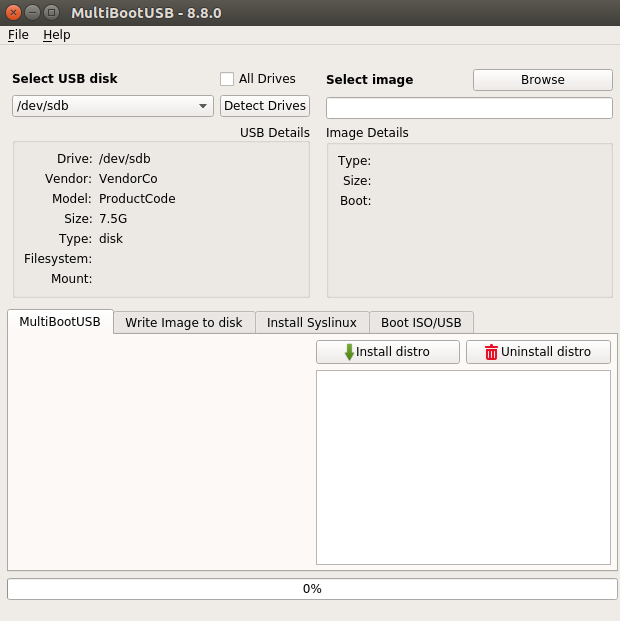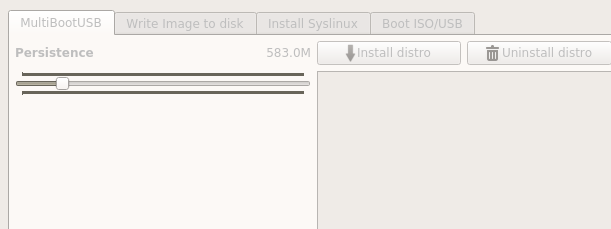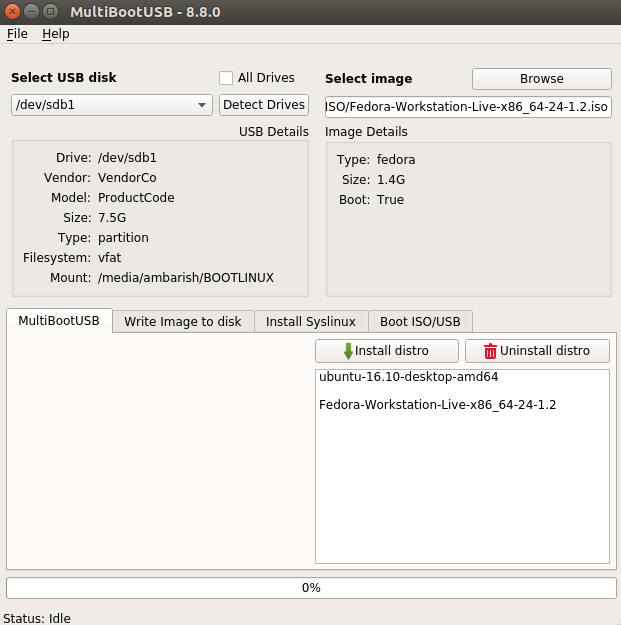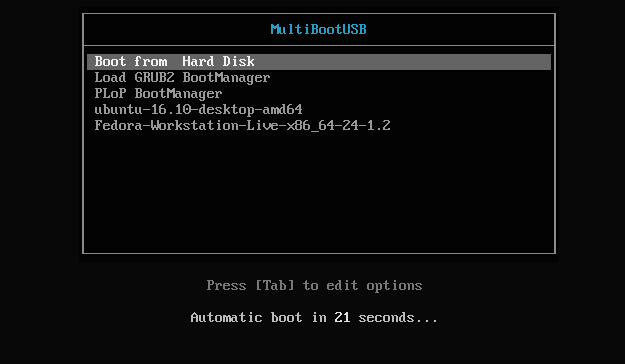Create installation disks for multiple Linux versions in MultiBootUSB
| Introduction | I like to try different Linux distributions via USB drives. It allows me to test the operating system on real hardware rather than in a virtualized environment. Additionally, I can plug the USB into any system (like a Windows system), do whatever I want, and enjoy the same Linux experience. And, if something goes wrong with my system, I can recover using a USB drive! |
We have a tool that can keep multiple Linux distributions on a single USB drive. All you need to do is select the distribution you want to install. In this tutorial, we will explain how to install multiple Linux distributions on a USB stick for live sessions.
Make sure you have a USB flash drive large enough to install multiple Linux distributions on it, an 8 GB USB flash drive should be enough for three or four Linux distributions.
step 1MultiBootUSB is a free, open source, cross-platform application that allows you to create USB flash drives with multiple Linux distributions. It also supports uninstalling any distro at any time, allowing you to reclaim space on your drive for another distro.
Download the .deb package and double-click to install.
Step 2The recommended file system is FAT32, so please make sure to format the USB drive before creating a multi-boot USB drive.
Step 3Download the ISO image of the Linux distribution you want to install.
Step 4After completing this, start MultiBootUSB.

The main screen asks you to select the USB drive and the Linux distribution image file you intend to put on the USB drive.
MultiBootUSB supports persistence of Ubuntu, Fedora and Debian distributions, meaning changes made to live versions of Linux distributions will be saved to USB.
You can select the persistence size by dragging the slider under the MultiBootUSB tab. Persistence gives you the option to save changes to a USB drive at runtime.

Click on the "Install Distro" option and proceed with the installation. It will take some time to complete before a successful installation message is displayed.
You can now see the distribution in the installed section. Repeat this process for additional operating systems. This is what it looked like after I installed Ubuntu 16.10 and Fedora 24.

The next time I boot via USB, I can choose either distro.

You can add as many distributions as your USB drive allows. To remove a distribution, select it from the list and click Uninstall Distribution.
Final wordsMultiBootUSB is really easy to install multiple Linux distributions on a USB flash drive. With just a few clicks, I have working disks of two of my favorite operating systems that I can boot on any system.
The above is the detailed content of Create installation disks for multiple Linux versions in MultiBootUSB. For more information, please follow other related articles on the PHP Chinese website!

Hot AI Tools

Undresser.AI Undress
AI-powered app for creating realistic nude photos

AI Clothes Remover
Online AI tool for removing clothes from photos.

Undress AI Tool
Undress images for free

Clothoff.io
AI clothes remover

Video Face Swap
Swap faces in any video effortlessly with our completely free AI face swap tool!

Hot Article

Hot Tools

Notepad++7.3.1
Easy-to-use and free code editor

SublimeText3 Chinese version
Chinese version, very easy to use

Zend Studio 13.0.1
Powerful PHP integrated development environment

Dreamweaver CS6
Visual web development tools

SublimeText3 Mac version
God-level code editing software (SublimeText3)

Hot Topics
 What computer configuration is required for vscode
Apr 15, 2025 pm 09:48 PM
What computer configuration is required for vscode
Apr 15, 2025 pm 09:48 PM
VS Code system requirements: Operating system: Windows 10 and above, macOS 10.12 and above, Linux distribution processor: minimum 1.6 GHz, recommended 2.0 GHz and above memory: minimum 512 MB, recommended 4 GB and above storage space: minimum 250 MB, recommended 1 GB and above other requirements: stable network connection, Xorg/Wayland (Linux)
 Linux Architecture: Unveiling the 5 Basic Components
Apr 20, 2025 am 12:04 AM
Linux Architecture: Unveiling the 5 Basic Components
Apr 20, 2025 am 12:04 AM
The five basic components of the Linux system are: 1. Kernel, 2. System library, 3. System utilities, 4. Graphical user interface, 5. Applications. The kernel manages hardware resources, the system library provides precompiled functions, system utilities are used for system management, the GUI provides visual interaction, and applications use these components to implement functions.
 vscode terminal usage tutorial
Apr 15, 2025 pm 10:09 PM
vscode terminal usage tutorial
Apr 15, 2025 pm 10:09 PM
vscode built-in terminal is a development tool that allows running commands and scripts within the editor to simplify the development process. How to use vscode terminal: Open the terminal with the shortcut key (Ctrl/Cmd). Enter a command or run the script. Use hotkeys (such as Ctrl L to clear the terminal). Change the working directory (such as the cd command). Advanced features include debug mode, automatic code snippet completion, and interactive command history.
 How to check the warehouse address of git
Apr 17, 2025 pm 01:54 PM
How to check the warehouse address of git
Apr 17, 2025 pm 01:54 PM
To view the Git repository address, perform the following steps: 1. Open the command line and navigate to the repository directory; 2. Run the "git remote -v" command; 3. View the repository name in the output and its corresponding address.
 Where to write code in vscode
Apr 15, 2025 pm 09:54 PM
Where to write code in vscode
Apr 15, 2025 pm 09:54 PM
Writing code in Visual Studio Code (VSCode) is simple and easy to use. Just install VSCode, create a project, select a language, create a file, write code, save and run it. The advantages of VSCode include cross-platform, free and open source, powerful features, rich extensions, and lightweight and fast.
 How to run java code in notepad
Apr 16, 2025 pm 07:39 PM
How to run java code in notepad
Apr 16, 2025 pm 07:39 PM
Although Notepad cannot run Java code directly, it can be achieved by using other tools: using the command line compiler (javac) to generate a bytecode file (filename.class). Use the Java interpreter (java) to interpret bytecode, execute the code, and output the result.
 What is the main purpose of Linux?
Apr 16, 2025 am 12:19 AM
What is the main purpose of Linux?
Apr 16, 2025 am 12:19 AM
The main uses of Linux include: 1. Server operating system, 2. Embedded system, 3. Desktop operating system, 4. Development and testing environment. Linux excels in these areas, providing stability, security and efficient development tools.
 How to run sublime after writing the code
Apr 16, 2025 am 08:51 AM
How to run sublime after writing the code
Apr 16, 2025 am 08:51 AM
There are six ways to run code in Sublime: through hotkeys, menus, build systems, command lines, set default build systems, and custom build commands, and run individual files/projects by right-clicking on projects/files. The build system availability depends on the installation of Sublime Text.






